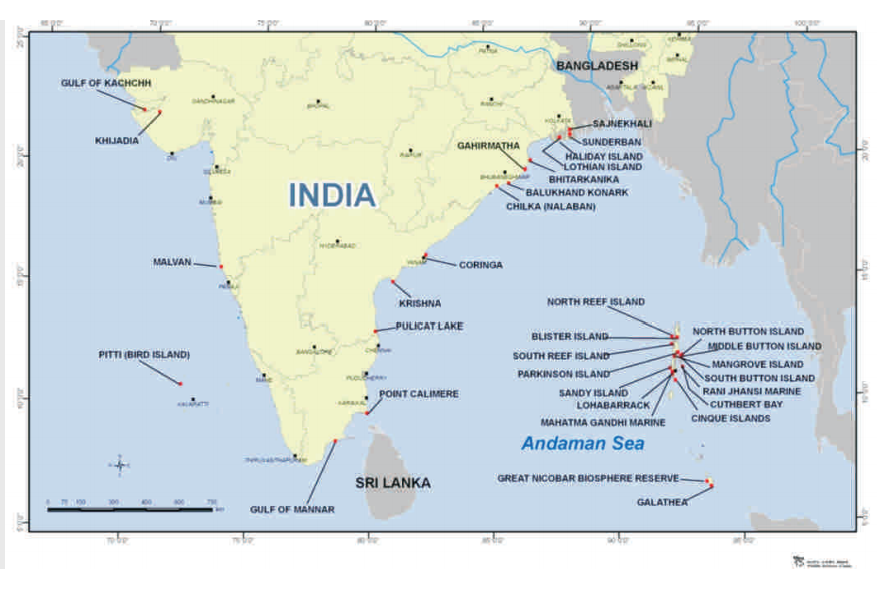India’s blue revolution needs more marine protected areas, says new research
What is the Marine Protected Area?
- A marine protected area (MPA) is essentially a space in the ocean where human activities are more strictly regulated than the surrounding waters – similar to national parks we have on land.
- These places are given special protections for natural or historic marine resources by local, state, territorial, native, regional, or national authorities.
What is an Exclusive Economic Zone?
- An Exclusive Economic Zone (EEZ) is a concept adopted at the Third United Nations Conference on the Law of the Sea (1982), whereby a coastal State assumes jurisdiction over the exploration and exploitation of marine resources in its adjacent section of the continental shelf, taken to be a band extending 200 miles (upto 321 kms) from the shore.
“30 by 30” target
- 30X30 is a call to action to safeguard at least 30% of the world’s ocean by 2030 through a network of highly protected marine areas where no destructive or extractive activities like Fishing or mining can take place.
Why in the news?
- A group of scientists have published a paper in journal Nature, stating that declaring parts of Exclusive Economic zones as Marine Protected Areas can boost fisheries yield, protect the ocean’s capacity to capture carbon and boost biodiversity.
- It is one of the important documents which is to serve as a reference point for the adoption of the 30×30 target in the upcoming UN Convention on Biological Diversity in Kunming, China, later this year.
- They stress the need for greater international cooperation to extend the boundaries of protection through MPAs.
- Although 7% of the world’s oceans are designated as MPAs currently, in practice, only 2.7% of MPAs are enjoying full or high levels of protection.
MPAs and food extraction
- Usually countries lower the standards of MPAs by reducing the protection with a thought that protected areas prevent extraction of food and materials.
- But scientists have found that expanding MPAs would actually produce overflow effects in other parts, which would raise the yield of food.
- If we strategically protect some of the oceanic area, we can boost our food stock upto 5.2 million metric tonnes.
How will MPAs help in protection of biodiversity?
- If we declare 43% of EEZs and 6% of the high seas of the world as MPAs, we can raise the protection of the endangered and critically endangered marine species upto 82% and 87% respectively.
- Among the seas recommended for enhanced protection are Antarctica, the Mid-Atlantic Ridge, the Mascarene Plateau, the Nazca Ridge and the Southwest Indian Ridge.
MPAs and Carbon capture
- Currently deep sea trawling and dredging are the most frequent ways of fishing in the world.
- But the above activities destabilise the sediments containing organic carbon and leading to remineralisation of the sedimentary carbon into CO2 and thereby lead to acidification of the ocean.
- The carbon released by above activities is equivalent to 15–20% of the atmospheric CO2 absorbed by the ocean each year. This affects the absorption of carbon by the ocean and ultimately adds to global warming.
- The areas with the highest priority are found where carbon stocks and present threats from human activity are the highest.
- Creating MPAs would stop large-scale dredging up of the carbon-laden sediments, with potential to reduce emissions.
India’s case
- India ranks relatively low among Asiatic nations in terms of the fraction of EEZ in the top 10% of priority areas.
- That means that India would benefit relatively more than others for reaching global conservation objectives.
- India’s bottom trawling for fisheries is thought to be responsible for annual CO2 emissions of the order of 28,83,128 tonnes. For comparison, it is 4,77,26,031 tonnes for Britain, and 76,92,94,185 tonnes for China.
- India is one of the top countries that will benefit greatly from fisheries reform and MPAs definitely can help improve fisheries in India. (figure denotes important MPAs of India)

References:
- http://www.wiienvis.nic.in/Database/MPA_8098.aspx
- https://stats.oecd.org/glossary/detail.asp?ID=884
- https://www.oceanunite.org/30-x-30/
- https://www.thehindu.com/sci-tech/science/indias-blue-revolution-needs-more-marine-protected-areas-says-new-research/article34093967.ece
- https://wii.gov.in/images/images/documents/GIZ/Reference.pdf
Subscribe
Login
0 Comments
